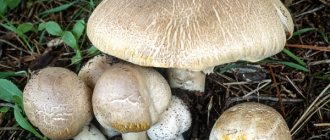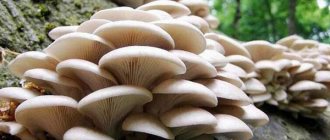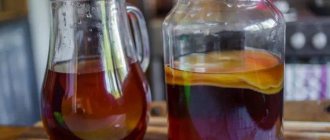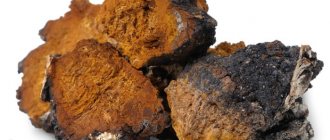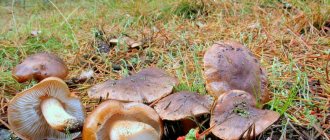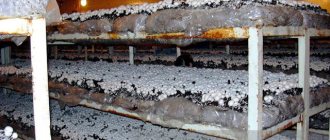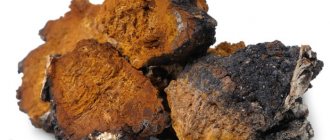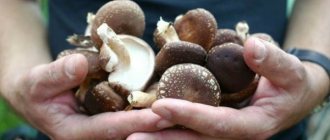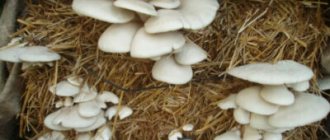Mechanism of action
The fungus begins to grow as a result of the proliferation of yeast and acetic acid fermentation of the nutrient medium. Medusomycete microorganisms use caffeine and tea tannin molecules to build their framework, which consists mainly of cellulose.
Yeast, in the process of its life activity, breaks down carbohydrates into carbon dioxide, and acetic acid bacteria present in the medium convert ethanol into acetic acid. As a result of these chemical transformations, a slightly carbonated drink with a sweet and sour taste is obtained - tea kvass.
Reproduction
The main problem when growing is planning the reproduction of the fungus. Reproduction of medusomycetes is carried out in 3 ways:
- Separation: take an old medusomycete, from which 1-2 plates of the mushroom body are separated. There is no need to cut or tear off pieces from the mushroom. You should only divide the mushroom with clean hands, and then it is important to rinse the resulting plates with clean water. Sometimes the surface of the mushroom is covered with a transparent film, which is carefully removed and placed in a nutrient liquid, which allows you to avoid separating the plates and not injuring the mushroom body. The disadvantages of the method are the increased risk of injuring the mycelium.
- Infusion: if you cannot find the junction of the plates, you can propagate the medusomycete using a ready-made solution. It must be poured into a clean glass container, and then placed in a dark place to infuse at a temperature exceeding +25 °C. After 1-2 weeks, you will notice that a new mushroom is floating on the surface of the liquid in the form of a thin translucent layer. This method has obvious advantages.
- Rebirth: In some cases, the organism itself is reborn. The aged mushroom body descends to the very bottom of the jar, and after a while a film separates from its upper layer, which floats to the surface of the liquid - this is the daughter organism.
If the mushroom is too old, they stop feeding it and use it to make vinegar, from which interesting dressings are then prepared. When the mushroom body dries out, it is possible to revive it with a nutrient solution.
Chemical composition
The origin, growth and development of kombucha is largely determined by the type of tea used. The chemical composition of the resulting tea drink will depend on this. Thus, a drink obtained by using black tea as a nutrient medium will contain more tannins, and green tea will contain more vitamins and caffeine. In addition, green tea kvass will contain more purine bases.
The drink obtained as a result of fermentation of tea infusion contains:
- carbohydrates (sucrose, fructose, glucose, cellulose);
- organic acids (acetic, lactic, citric, oxalic, glucuronic, phosphoric, kojic, malic, pyruvic);
- enzymes (amylase, lipase, protease, carbonic anhydrase, catalase);
- lipids (fatty acids, sterols, phospholipids);
- proteins and purine bases;
- pigments (chlorophyll, xanthophyll);
- antibiotics;
- tannins;
- alcohols and aldehydes;
- resins;
- alkaloids;
- glycosides;
- vitamins;
- minerals.
Vitamins
| Name | Content in 100 ml of drink, milligrams |
| Provitamin A (beta-carotene) | 0,04-0,12 |
| Vitamin B1 (thiamine) | 0,1 |
| Vitamin B2 (riboflavin) | 0,15-0,3 |
| Vitamin B6 (pyridoxine) | 0,1 |
| Vitamin B12 (cyanocobalamin) | 0,005 |
| Vitamin PP (nicotinic acid) | 1,0 |
| Vitamin D (ergocalciferol) | 0,05 |
Consuming just 100 ml of tea kvass can provide the human body with the daily requirement of vitamin B12 (cyanocobalamin) and vitamin D (ergocalciferol).
From live beer
Many experimenters are interested in whether it is possible to grow kombuchas using beer? It turns out that it is possible! This method of growing medusomycetes stands out for its simplicity and excellent results.
You will need:
- sterile 1 liter jar (naturally dried in advance);
- multilayer gauze fabric;
- boiling water (1 liter);
- sugar 1 tbsp (as an alternative, natural honey diluted in water at a temperature of about 20°C is suitable);
- 1 tbsp tea leaves (large leaf, without aromatic impurities);
- unpasteurized beer 100 ml;
- sour wine 1 tbsp.
Cooking method:
- Take a jar and add live beer (unpasteurized) to it.
- First add sugar to beer, and then sour wine.
- Mix thoroughly, cover tightly with gauze and hide in a warm, very dark corner.
- After just 1.5 weeks, you can remove the small tea jellyfish from the beer and move it to the tea environment.
Beneficial features
The rich composition of kvass from medusomycetes provides a huge range of beneficial properties for the human body, which it exhibits when consumed internally and externally.
For the digestive system
The tea drink stimulates the production of digestive juices, which promotes digestion. The enzymes contained in it reduce the load on the digestive glands (salivary, gastric, pancreas, liver).
The vitamin composition of tea kvass suppresses the proliferation of pathogenic intestinal microorganisms and maintains normal intestinal microflora. Thanks to the high concentration of B vitamins, Japanese mushroom kvass improves the body's immunity and resistance.
Regular consumption of this infusion in food reduces inflammatory reactions in the digestive tract. Fiber and other polysaccharides of the drink prevent the absorption of cholesterol from the intestines, absorb and remove toxic substances and waste from the body, prevent bloating and normalize stool.
For the condition of the heart and blood vessels
Tea kvass, when taken orally regularly as a remedy, normalizes heart rhythm, reduces heart rate, lowers blood pressure, tones the walls of venous vessels and has an anti-inflammatory effect.
Its components help reduce the concentration of cholesterol in the blood. Due to its anticoagulant effect, the drink improves microcirculation in tissues.
For the general condition of the body
The tea drink normalizes metabolism in the body, which has a beneficial effect on the general condition of a person, increases his vitality and improves his mood. Drinking the drink warm at night has a calming and hypnotic effect.
By promoting hematopoietic functions, kvass from medusomycetes increases the amount of hemoglobin in the blood and immunity. Taking the tea drink internally has powerful antioxidant and detoxifying effects on the human body. Literary sources contain information about the anticancer properties of this kvass.
External products based on this drink improve the condition of the skin and its appendages (hair, nails), relieve inflammation, and reduce allergic dermatological reactions.
Kombucha treatment
Since ancient times, kombucha has been considered an elixir for many diseases. Not so long ago it was grown in almost every Soviet family. Currently, not only fans of traditional medicine know about the beneficial properties of the mushroom - they are confirmed by modern clinical studies.
Treatment of nails with kombucha
There is such a disease as onychocryptosis - this is when the nail grows into the side of the nail fold. This usually happens on the big toe. In the early stages, the disease is accompanied by inflammation of the soft tissues, and in the later stages purulent discharge appears. If the disease starts, then in the future it is simply impossible to do without surgical intervention.
With timely treatment, natural medicines based on folk recipes, including kombucha, give very good results. It is used in the form of compresses. First of all, we peel the mushroom, then we wrap it around the sore finger and cover it with cling film, put on a simple sock, and then a woolen one. The ingrown toenail softens after just three similar procedures, and you can remove it yourself.
For hair
There are many ways to care for your hair using kombucha. Preparations from it help strengthen hair, make it thicker and accelerate growth; the mushroom is used in the treatment of various scalp diseases. In case of hair loss, the infusion of kombucha should be rubbed into the scalp with light massaging movements. For a richer and more intense color, as well as to make your hair soft and shiny, it is recommended to rinse your hair with mushroom infusion after washing your hair.
To improve the internal condition of the hair, an infusion of kombucha can be drunk daily before meals. This will not only help strengthen your hair, but will also have a beneficial effect on its growth. If you need to get rid of dandruff, then do the following: divide your hair into strands and along the parting line, lubricate the roots with a piece of gauze soaked in the mushroom infusion. After 30–40 minutes, rinse. It is advisable to carry out this procedure after each hair wash.
To strengthen your hair, you can also mix one tablespoon of honey with one glass of mushroom infusion. The mixture should be heated slightly, without bringing to a boil, and mixed thoroughly. The mask should be applied evenly to damp hair. After 20–30 minutes, you can rinse your head with chamomile infusion.
For nail fungus
Fungal infection of the nails is a chronic disease that steadily destroys the nail plates and threatens to spread to other people, especially family members. The disease is an entry point for many other infectious diseases; it leads to allergization of the entire body, development or worsening of diseases such as bronchial asthma, allergic dermatitis, eczema and others.
This is why the fungus should not be allowed to spread, especially since the disease is easily treated with kombucha. To do this, separate a thin plate from the fungus and wrap it around the sore finger overnight. Cover the lotion with cellophane on top and put on several socks so as not to stain the bed linen, as juice will leak out of the mushroom. The first reaction will most likely be painful, but if you overcome this, you can get rid of the disease once and for all.
In the morning, the compress should be removed, the leg should be washed in warm water, the dead pieces of skin should be cut off and the entire damaged surface should be treated with brilliant green or a solution of potassium permanganate. The procedure should be repeated every other day, and so on until the signs of the disease completely disappear. This usually requires up to seven approaches. After completing the course of treatment, the procedure can be repeated for prevention. The new nail will grow slowly, but it will be smooth and healthy.
For gastritis
Today, gastritis is the most common disease of the gastrointestinal tract. The disease is characterized by damage to the gastric mucosa and its inflammation. The causes of the disease may be poor nutrition, excessive drinking, smoking, long-term use of toxic medications, etc.
A mixture of kombucha and honey will help get rid of pain and heaviness in the stomach. For the first 7–10 days when taking mushroom infusion, a light diet is recommended, then you can gradually add spices and bitterness to your food, for example, barberry, dill, and hops. Tea kvass is consumed 3 times a day, 100 ml.
Infusion: Crushed chestnut bark must be added to boiling water at the same time as the tea leaves. Infuse for 20–30 minutes, then strain and consume a quarter glass of kombucha infusion 3 times a day, 1 hour before meals, for two weeks.
For diabetes
Kombucha is good because it can normalize metabolism in the human body, including carbohydrates. It is this feature that is used in the treatment of diabetes. However, the mushroom can not be consumed in all forms of the disease; in this regard, it is best to consult with your doctor. Just one glass of kombucha infusion per day, divided into 3-4 servings, will significantly improve the functioning of the entire body, mobilize internal reserves to fight the disease, and ensure a gradual decrease in blood sugar levels.
For patients with diabetes, when drinking the drink, it is recommended to dilute the mushroom with mineral water or herbal tea, while for two liters of tea it is enough to add only 70–80 g of sugar. In addition, during its life, kombucha processes sugar without leaving any residue.
For stomach ulcers
If you have high acidity or stomach ulcers, you should not drink kombucha. As an exception, you can use an infusion of mushroom with honey, prepared using only black tea. Honey neutralizes the effects of acid, eliminating exacerbations.
For children
The drink made from kombucha is very healing and tonic; it can also be consumed by children. It is a good substitute for carbonated drinks. Although it is not advisable to accustom children to tea kvass from a very early age. Even a minimal amount of alcohol and caffeine, if consumed regularly, will negatively affect the child’s body. For children, the best drink is clean water, and dessert is compotes, juices, fresh fruit purees, and fruit drinks.
During pregnancy
Tea kvass can be consumed during pregnancy only if the woman does not have allergic reactions to the polysaccharides and acids that make up kombucha. Regular use of this healing drink will help strengthen the body's protective functions and maintain a woman's well-being.
It is possible and even necessary to use the infusion during lactation, also provided that the mother and baby are not allergic to the components included in the kombucha.
Harmful properties
The active substances contained in this drink in large quantities can also exhibit harmful properties in some diseases and conditions.
In order not to aggravate the patient’s condition, the use of tea kvass is contraindicated in case of inflammatory diseases of internal organs in the acute phase.
Possessing high acidity, the medusomycete infusion is contraindicated for use in gastritis with high acidity, gastric and duodenal ulcers in the acute stage.
The drink is contraindicated for gout and urolithiasis because it contains oxalic acid and purine bases.
You should not drink an infusion of Japanese mushroom before work that requires quick reaction and concentration, for example, driving a car, operating conveyors and conveyors.
The sugary compounds included in the drink increase the concentration of glucose in the blood, so its use is not recommended for diabetics.
The active compounds of kvass can interact with the active ingredients of various medications, so its use is prohibited simultaneously with painkillers, antipyretics, sedatives, hypnotics, tranquilizers, antacids, anticoagulants and antiplatelet agents.
Contraindications to the use of this drink are reduced blood clotting (clotting factor deficiencies, thrombocytopenia, pancytopenia).
The acids in the tea drink are easily oxidized and can react with the dishes in which it is infused, so the Japanese mushroom cannot be grown in ceramic, metal or clay dishes.
Tea kvass, due to the content of alcohols and aldehydes, is contraindicated in childhood, pregnancy and breastfeeding.
Drinking the drink is prohibited if you have individual intolerances or allergies.
Use in folk medicine
The multiple beneficial properties of a drink based on a Japanese mushroom allow traditional healers to successfully use it in the treatment of various chronic diseases:
- ENT organs and upper respiratory tract (bronchitis, laryngitis, tonsillitis, rhinitis, sinusitis, otitis);
- digestive organs (gastritis with low acidity, pancreatitis, bile stagnation, constipation, dysbacteriosis);
- organs of the excretory system (pyelonephritis, glomerulonephritis, cystitis);
- various forms of tuberculosis;
- iron-, folate- and B12-deficiency anemia;
- exhausted states.
The influence of the drink's components on vascular tone and heart rhythm makes it possible to use it for atherosclerosis, arterial hypertension, arrhythmia, transient cerebral circulation disorders, multiple sclerosis, senile dementia, and migraines. The anticoagulant effect of kvass is useful for thrombophilia, varicose veins, and thrombophlebitis.
Traditional healers recommend drinking the tea drink in the initial stages of cancer. It improves the well-being of cancer patients after chemotherapy or radiation treatment.
Health promotion, disease prevention
The drink promotes:
- increasing the body's defenses;
- saturating it with vitamins;
- activation of brain processes;
- filling with energy;
- improving blood circulation;
- providing a preventive effect during an epidemic of ARVI and influenza (the immunomodulatory and bactericidal properties of the drink help fight the first signs of a cold, but it is impossible to cure a viral disease with this remedy);
- eliminating anxiety, nervous tension, insomnia. The composition taken at night will have a calming effect and speed up the process of falling asleep.
Benefits for weight loss
It is recommended to introduce a drink made from medusomycetes into the diet of people who are struggling with excess weight. The substances contained in it improve the breakdown and absorption of nutrients, thereby normalizing the digestion process and healing the intestinal biocenosis. Fiber and other polysaccharides in kvass prevent constipation, which often accompanies the process of losing weight.
In order for the Japanese mushroom to promote weight loss, an infusion of it must be taken, adhering to certain rules:
- You need to infuse a diet tea drink with green tea.
- Drink one hour before meals or two hours after meals.
- A single dose is 1 glass (250 ml), the maximum daily dose is 6 glasses.
- The duration of the continuous course should not exceed 1 month.
- A break of at least one week is required between courses.
- Drinking the drink does not replace dietary nutrition and physical activity.
- The caloric content of the drink should be taken into account when calculating the daily caloric intake (based on the glucose content in 100 ml).
With proper use of tea kvass, you can get rid of 7 kg of weight in one month.
Kombucha recipe
The taste of the drink directly depends on what solution you use. The classic option is to brew 4 tablespoons of loose leaf tea per standard volume. This amount will require about a glass of sugar. You can experiment with green tea, compote, juice, rose hips, and herbal infusions.
Avoid chamomile, sage and other herbs with a high content of essential oils, because they change the structure of the drink when fermented. Instead of sugar, try jam, preserves or honey. When replacing the liquid, leave a little of the old drink so that the process is more active.
Photo: kacrb.ru
External use
The use of a Japanese tea drink as a remedy for external use is indicated for inflammatory diseases of the eyelids (conjunctivitis, barley on the eyelid), skin (dermatitis, furunculosis), burns, purulent wounds, trophic ulcers, varicose nodes. Tampons soaked in tea kvass are used for hemorrhoids. The organic acids of the drink soften dry calluses and reduce pain from heel spurs.
The application of compresses with kombucha infusion is indicated for mastitis, subcutaneous abscesses, bruises, arthritis, and insect bites. Tea kvass is also often used in cosmetology to make lotions, tonics, masks, and balms for problematic facial skin, hair, and nails.
Contraindications
Despite all the beneficial properties of kombucha, not everyone can use it. Even a mushroom grown with your own hands can be harmful to your health. It is not recommended for use by those who suffer from diabetes. It is a bad help for those who have problems with any fungal diseases. Particular caution should be exercised by pregnant and nursing mothers. And all other categories of citizens should not forget that the infusion contains a small percentage of alcohol.
How to grow
Kombucha bacteria are aerobes, meaning they cannot live without oxygen. Therefore, in the process of growing medusomycetes, it is very important that there is constant access to air to the infusion. The process of growing kombucha looks like this:
- Wash and rinse thoroughly a glass jar (preferably a 3-liter one).
- Using purified boiled water, you need to prepare weak (black or green) tea with sugar (2 teaspoons of tea, 1 liter of water, 50 g of sugar). Strain until the infusion is clear.
- Tea should be large-leaf, without flavorings or dyes. Sugar must be completely dissolved in tea.
- Place a Japanese mushroom at the bottom of the prepared container and pour in tea at room temperature.
- Cover the neck of the jar with gauze. Leave in a bright place, avoiding direct sunlight on the mushroom.
At first, the medusomycete will lie at the bottom of the jar, but as it grows and matures it will rise to the surface. The drink can be consumed no earlier than after 7 days. Until this time, it contains a lot of sugar. It is also not worth keeping the infusion for longer than 10 days, since acetic acid will progressively accumulate in it.
After draining the kvass into the jar with the mushroom, you need to add freshly prepared tea. Every week or every two weeks a new layer will appear in the jellyfish. The layers can be separated: this is how it multiplies.
If during the growing process the jellyfish sank to the bottom, it needs to be treated. To do this, it is taken out of the container, the old infusion is drained, and the jar is thoroughly washed. The body of the mushroom is examined. The dark layers are separated and discarded. The remaining jellyfish is dried and then dipped into freshly prepared tea infusion at room temperature. If after a few days she has not risen to the surface, this means that she has died. It is strictly prohibited to consume tea kvass obtained by infusing dead mushrooms.
If you plan to make the drink for regular use, then it is better to prepare two glass containers at once: in one the mushroom will grow and the drink ripens, and in the other the finished tea kvass will be stored.
Best materials of the month
- Coronaviruses: SARS-CoV-2 (COVID-19)
- Antibiotics for the prevention and treatment of COVID-19: how effective are they?
- The most common "office" diseases
- Does vodka kill coronavirus?
- How to stay alive on our roads?
Key Features
It is not at all correct to call kombucha a plant, and it is not even really a mushroom. Previously it was believed that this was a single organism, which was given the name “medusomycete”. But it’s even more interesting: this is a symbiosis of a yeast fungus with a bacterium. Moreover, there is no exact composition and cannot be, because both fungi and bacteria can be of completely different genera.
Chinese traditional medicine has used kombucha since before our era. It was from there that, two decades later, he made his way to the Far East, and then to Europe. It was considered a drink of immortality and a real healing elixir.
Externally, kombucha resembles a jellyfish, with threads radiating from its smooth dome. Color varies from pale yellow to pinkish or brownish. If you grow it at home in a jar, it is more like a multi-layered pancake, but this does not affect the taste in any way.
Photo: araratkafe.ru
How to drink
For medicinal purposes, it is necessary to take the drink warm (but not hot) half an hour before meals or 2 hours after it. The volume of drink consumed per day is about 0.5 liters, which should be divided into three doses. The course of treatment is 1.5-2 months with a further one-month break.
The tea drink can be combined with other folk remedies (with decoctions or infusions of medicinal herbs, bee products, with mumiyo).
The drink should be slightly carbonated and sour. The appearance of a sharp sour taste, smell of alcohol or vinegar indicates that the fermentation process has been disrupted. You can't drink such a spoiled drink.
From rosehip
There are a lot of variations of recipes with herbs. Most often, regular tea is combined with rose hips, linden flowers, strawberries, currant and raspberry leaves.
The most useful will be an infusion brewed with nettle, plantain, and blackthorn. It is better not to add herbs that have essential oils in their chemical composition (for example, sage or chamomile).
How to grow kombucha from scratch at home from actual rose hips?
You will need:
- You can use a thermos or a glass bottle as a container for cooking;
- tea leaves 1 tbsp;
- rose hips (10-20 pieces);
- boiling water (1 liter);
- granulated sugar 2 tbsp;
- multilayer gauze fabric.
Preparation method (in bottle):
How to grow truffles: technology for growing at home. Breeding recommendations for beginners (120 photos and videos)What honey mushrooms look like: 105 photos of edible and false honey mushrooms. How to distinguish and how to cook mushrooms
Homemade oyster mushrooms: growing tips for beginners. Pros and cons of growing mushrooms at home (110 photos)
- Brew tea leaves with boiling water.
- After 10 minutes, strain and cool.
- Add granulated sugar.
- Pour into the prepared container, add rose hips.
- Cover the container with gauze and hide it in a warm place, protected from sunlight.
- The tea jellyfish is formed in 1-1.5 months.
Method of preparation (in a thermos):
- Place rose hips in a thermos.
- Pour boiling water or hot tea (not to the brim), strained through a sieve and without traces of tea leaves.
- We close the valve of the thermos for a long time (6-8 weeks).
- After the exposure period has expired, we take out a dense, mucous disc-shaped formation from the thermos, which we move into a glass container for further growth.
